THE SHORT OXFORD HISTORY OF ENGLISH LITERATURE
THE SHORT OXFORD HISTORY OF ENGLISH LITERATURE
THE SHORT OXFORD HISTORY OF ENGLISH LITERATURE
You also want an ePaper? Increase the reach of your titles
YUMPU automatically turns print PDFs into web optimized ePapers that Google loves.
of her social liberation, but on a series of interlinked relationships all of which humourlessly suggest something of the<br />
shabby and disappointed state of contemporary England. Drabble touches on corrupt property-developers and IRA<br />
bombs, on broken marriages and the alienations of upward social mobility, on rural withdrawal and on what was then<br />
the ‘other world’ of Eastern Europe (if awkwardly glimpsed as Walachia, ‘the most obscure and mysterious of the<br />
Communist states’, a benighted country where one of the characters cannot buy sanitary towels). Each novel’s setting<br />
seems to imprison its, sometimes willing, occupants. The process of negotiating a release is, as so often in Drabble’s<br />
work, a precarious and unsatisfying one. Her England is not so much a promised land as a focus of redundant<br />
promises.<br />
[p. 620]<br />
Drama since the 1950s<br />
After more than sixty years of proposals, high hopes, and false starts, Britain finally got its National Theatre in July<br />
1962. More precisely, it got an official announcement that a National Theatre was to come into being. A Board was<br />
established and in October 1963 a National Theatre Company presented its inaugural production of Hamlet in the<br />
cramped, but venerable, surroundings of the Old Vic (the Company was not able to move the relatively short distance<br />
to its partially completed new building on the south bank of the Thames until March 1976). Since its inception, the<br />
National Theatre (from 1988, the Royal National Theatre) has always had serious rivals, in terms of both prestige and<br />
innovation. In the 1960s and 1970s Britain’s other subsidized ‘national’ theatre, the Royal Shakespeare Company,<br />
established an enviable record of experiment (though it has since largely concentrated on the work of Shakespeare and<br />
his contemporaries). For a remarkable, if relatively brief, period, which began with the formation of the English Stage<br />
Company in 1956, one commercial theatre, the Royal Court, also seemed to lead the way in encouraging,<br />
commissioning, and presenting the work of new dramatists, both native and foreign. In their different ways, all three<br />
companies engineered a London-based theatrical revolution.<br />
Although the National Theatre had called on the services of the unconventional Kenneth Tynan as its literary<br />
adviser, its choice of plays and directors was initially somewhat cautious. The Royal Shakespeare Company, by<br />
contrast, startled audiences out of any sense of stability and complacency with four particularly celebrated productions<br />
by the director, Peter Brook (b. 1925): a much admired and starkly Beckettian King Lear in 1962; a version of the<br />
German dramatist, Peter Weiss’s, play known colloquially as the Marat/Sade in 1964; and, following Brook’s<br />
exploratory ‘Theatre of Cruelty Season’, the experimental Artaudian commentary on the Vietnam war, US, in 1966.<br />
Perhaps most stunning and provocative of all was his complete rethinking of A Midsummer Night’s Dream in 1970, a<br />
rethinking which swept away fairyland glades and gauzes and boldly substituted dazzling light, erotic gestures, and<br />
perilous acrobatics. When Brook declared that his production of the Marat/Sade had been designed to ‘crack the<br />
spectator on the jaw, then douse him with ice-cold water, then force him to assess intelligently what has happened to<br />
him, then give him a kick in the balls, then bring him back to his senses again’, he was stating an extremist principle<br />
of what has come to be known as ‘director’s theatre’ (though it was a principle which could be said to have<br />
determined many of the effects of the ‘political’ theatre of the 1970s). It was not a principle on which the Royal Court<br />
generally worked. Its intellectual assaults were of a different, though not necessarily more subtle, order.<br />
John Arden (b. 1930) was in many ways typical of a new generation of playwrights launched at the Royal Court:<br />
provocative, argumentative, brusque, and<br />
[p. 621]<br />
Anglo-Brechtian. Arden’s LiveLike Pigs (1958), a play about the resettlement of gypsies in a housing-estate, explores<br />
anti-social behaviour. It leaves the firm impression that ‘respectability’ and its official guardians, the police, were<br />
ultimately far more damaging to society than the unconventional mores of the play’s gypsies. Arden’s most celebrated<br />
and punchy play, Serjeant Musgrave’s Dance (1959), addresses its anti-militaristic theme with a combination of<br />
Brechtian exposition and music-hall routines (dance, song, and monologue). Although the play grew out of<br />
contemporary circumstances (army conscripts, recruited under the system known euphemistically as ‘National<br />
Service’, had recently suffered casualties in the campaign in Cyprus), its setting is loosely Victorian. Its red military<br />
tunics, its black bibles, its narrow logic, and its unresolved social tensions are all designed to disconcert audiences and<br />
to raise questions about the principles of duty, rigidity, and order. When Arden reworked his play in 1972 as Serjeant<br />
Musgrave Dances On he gave it a far more overt and direct political message, one focused on the engagement of<br />
British troops in Ulster. Serjeant Musgrave Dances On may have grown out of Arden’s steady questioning of British<br />
political, legal, military, and imperial traditions in plays such as Left-Handed Liberty (1965), The Hero Rises Up









